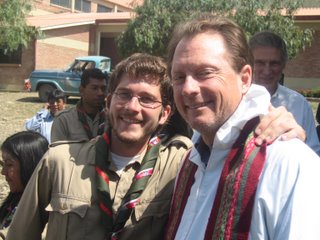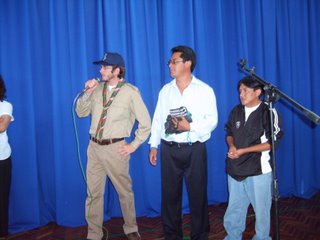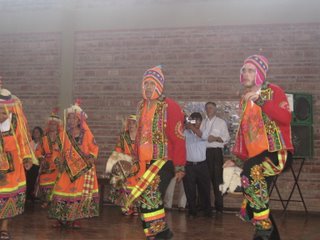After nearly a two-month hiatus from my blog, I owe an apology to all of the readers interested in the continued growth of the mission here at Amistad. As we begin this new year, one of my resolutions is to give regular and focused attention to updating the blog. The challenge, of course, is to make a sustained effort for the duration of the year and not merely for several months, as is often the case with this type of resolution.
Anyway, in my absence from the blog, many exciting things have happened here in the Villa. Perhaps the greatest of all of these was the 16th Anniversary celebration of the Mission. On a beautiful Saturday in early December, many of the involved parties in the Mission came together for this unique commemoration. Apart from the children, mamás and tías, and workers and administrators of the Villa, we were blessed to have the company of the staff and beneficiaries of the Mission’s work in Aramasi, former Amistad workers, and most especially, several friends and board members of the Mission from the U.S.
We began the day by introducing our newly-formed Scouts program, which has been an operational project for about two months, with children from the Villa and also from a nearby community participating in group activities every Saturday morning. Children lined up according to their respective groups (Wolf, Pioneers, and Explorers) and saluted in the proper manner the raising of the Scout flag.
Once this introductory activity was completed, we, as leaders of the Scout groups, enlisted the help of the children to seat all of the invited guests outside of Casa San Martín. After several years of disuse, this house was reopened under the direction of a new mamá, Marisa. In order to properly honor this special occasion, Reverend Ken Swanson (a celebrity for these children) introduced the visitors to those who would live in the house. Following this introduction, Reverend Swanson gave a blessing for the prosperity and growth of all who entered into the house, that God protect and keep them in his graces. The mamá and oldest girl of the house then cut the ceremonial red ribbon and entered with the rest of the family, while we all joined in songs of praise led by our choral director, Douglas.
 Following the blessing of Casa San Martín, we went to the gymnasium to honor and give plaques to the mamás who work tirelessly to give the children of Amistad a better life. As I have said in previous posts, their dedication should be praised and recognized continuously. They truly are the heart of this institution. The presentation of plaques to the mamás was followed by a moving moment for us all. Vladimir, one of the youths living in the Boys Transition House, approached the microphone and timidly expressed his gratitude for the work and kindness of the members of the Amistad board who had taken the time to visit. As a symbol of this gratitude, he presented each member with a hand-woven pouch that he had personally made over the course of the year. What continues to touch me most about Vladimir’s gifts, however, is the fact that this selfless youth is blind. He, of all the children in the Mission, wanted the supporters of Amistad to understand how much he appreciates them. His efforts and perseverance are an example of one of the many success stories that have and continue to come from children in the Mission.
Following the blessing of Casa San Martín, we went to the gymnasium to honor and give plaques to the mamás who work tirelessly to give the children of Amistad a better life. As I have said in previous posts, their dedication should be praised and recognized continuously. They truly are the heart of this institution. The presentation of plaques to the mamás was followed by a moving moment for us all. Vladimir, one of the youths living in the Boys Transition House, approached the microphone and timidly expressed his gratitude for the work and kindness of the members of the Amistad board who had taken the time to visit. As a symbol of this gratitude, he presented each member with a hand-woven pouch that he had personally made over the course of the year. What continues to touch me most about Vladimir’s gifts, however, is the fact that this selfless youth is blind. He, of all the children in the Mission, wanted the supporters of Amistad to understand how much he appreciates them. His efforts and perseverance are an example of one of the many success stories that have and continue to come from children in the Mission. Once each of the board members had been individually acknowledged and thanked by Vladimir, we settled in to view a theatrical performance by the children of the Villa. The short play, developed over the span of nearly two months, dealt with a dream world inhabited by fantasies and nightmares. Carla, a very intelligent young girl from Casa Esperanza, played the role of the Queen of Dreamland who helped all who entered to realize their goals. After being captured by the cruel inhabitants from the Land of Nightmares, Carla was rescued by two young dreamers (Bárbara from Casa San Francisco and Jhenny from Casa Copacabana) who used laughter to conquer their fears of the nightmares. The play ended with the message that all dreams can come true through hardwork and perseverance and that no impediment, such as a nightmare, is too great to overcome.
Once each of the board members had been individually acknowledged and thanked by Vladimir, we settled in to view a theatrical performance by the children of the Villa. The short play, developed over the span of nearly two months, dealt with a dream world inhabited by fantasies and nightmares. Carla, a very intelligent young girl from Casa Esperanza, played the role of the Queen of Dreamland who helped all who entered to realize their goals. After being captured by the cruel inhabitants from the Land of Nightmares, Carla was rescued by two young dreamers (Bárbara from Casa San Francisco and Jhenny from Casa Copacabana) who used laughter to conquer their fears of the nightmares. The play ended with the message that all dreams can come true through hardwork and perseverance and that no impediment, such as a nightmare, is too great to overcome.The play concluded the morning’s activities, and we all retired to the basketball court outside (luckily shaded on this sunny day) to enjoy a typical Bolivian lunch. Each visitor was treated to one of two plates, picante de pollo (spicy chicken, plantain, potato, corn, and salad) or charque (beef, potato, corn, egg, a grain called mote, and salad). As is often the case in Bolivia, the quantity of food was more than enough to satisfy one’s hunger. After finishing my plate, I excused myself to change from my Scout uniform into more formal attire for my afternoon MC duties.
The afternoon program kicked off with a cultural presentation and exposition of the works developed by the children of the Villa during the year in their classes of arts and crafts. Nine groups, representing each of the departments of Bolivia, of three to four children showed off the fruits of their labor while dancing around the gymnasium in attire typical of their represented department. The occasion served as an opportunity to orient the North American visitors to another aspect of Bolivian culture, as well as the impressive art of the Villa children.

 In addition, this cultural exposition proved to be an appropriate transition to the next activity of the day: Bolivian dances. Once again, each of the nine departments were represented in a series of dances performed by children of the Villa and the boys’ and girls’ transition houses, women and their babies from Aramasi, workers and administrators of the Villa, and yes quite comically, yours truly. After the third dance, I had to relinquish the microphone to change into my indigenous garb. The dance I performed with administrators, workers, mamás and tías of the Villa is called Tinkus, which means “encounter.” It has its origins in Potosí, a mining region in southern Bolivia, and involves rival tribes who meet up several times per year to combat one another for land and women, among other things. After a month of practice once or twice per week, I felt pretty comfortable with the steps. Luckily during the performance, I did not embarrass myself additionally apart from being a clumsy gringo. In the dance, I had the dubious honor of being the winner. I say dubious, because the winner obviously receives the accolades of a champion, but it also means that you have to dance around longer than anyone else. We had never practiced in the full Tinkus attire, and by the end of the dance, I felt its weight. I was no happier than when we began to parade off stage and return to the dressing room (a.k.a. the bakery). I now have a profound respect for the traditional dancers who perform not one, but close to a dozen different dances in their shows.
In addition, this cultural exposition proved to be an appropriate transition to the next activity of the day: Bolivian dances. Once again, each of the nine departments were represented in a series of dances performed by children of the Villa and the boys’ and girls’ transition houses, women and their babies from Aramasi, workers and administrators of the Villa, and yes quite comically, yours truly. After the third dance, I had to relinquish the microphone to change into my indigenous garb. The dance I performed with administrators, workers, mamás and tías of the Villa is called Tinkus, which means “encounter.” It has its origins in Potosí, a mining region in southern Bolivia, and involves rival tribes who meet up several times per year to combat one another for land and women, among other things. After a month of practice once or twice per week, I felt pretty comfortable with the steps. Luckily during the performance, I did not embarrass myself additionally apart from being a clumsy gringo. In the dance, I had the dubious honor of being the winner. I say dubious, because the winner obviously receives the accolades of a champion, but it also means that you have to dance around longer than anyone else. We had never practiced in the full Tinkus attire, and by the end of the dance, I felt its weight. I was no happier than when we began to parade off stage and return to the dressing room (a.k.a. the bakery). I now have a profound respect for the traditional dancers who perform not one, but close to a dozen different dances in their shows. Several additional dance performances followed, and then we set up the gymnasium for the final activity of the day: the mass. The presence of three religious figures made the celebration of the mass particularly special. Reverend Ken Swanson from Christ Church Cathedral in Nashville, Father Steve Judd from the Maryknoll Language Institute in Cochabamba, and Bishop Tito Solari of Cochabamba. Together, they provided a service in Spanish and English that emphasized the ecumenical goals of the Mission and the continued cross-cultural support that helps to achieve these goals. With the participation of children, mamás and tías, administrators, and friends of the Mission, this mass was a fitting conclusion to the day’s events, as it reminded us of our spirituality, unity, and purpose in our work within Amistad.
Several additional dance performances followed, and then we set up the gymnasium for the final activity of the day: the mass. The presence of three religious figures made the celebration of the mass particularly special. Reverend Ken Swanson from Christ Church Cathedral in Nashville, Father Steve Judd from the Maryknoll Language Institute in Cochabamba, and Bishop Tito Solari of Cochabamba. Together, they provided a service in Spanish and English that emphasized the ecumenical goals of the Mission and the continued cross-cultural support that helps to achieve these goals. With the participation of children, mamás and tías, administrators, and friends of the Mission, this mass was a fitting conclusion to the day’s events, as it reminded us of our spirituality, unity, and purpose in our work within Amistad.Unfortunately, this momentous celebration could not last. With the conclusion of the mass, we had to say our goodbyes to the people of Aramasi, former workers of Amistad, and most sadly, our friends from the States. During the three days that they had been in Cochabamba, these visitors had the opportunity to see the achievements of the Mission, both in the Villa and in Aramasi. They were able to admire the continued construction of the lined, cobblestone road running through the Villa,
 the lovely mural of the Virgin Mary and Jesus painted on the door of the gymnasium,
the lovely mural of the Virgin Mary and Jesus painted on the door of the gymnasium, and the beautiful grotto and fountain that honors the Virgin of Rosario (the Virgin was removed for cleaning).
and the beautiful grotto and fountain that honors the Virgin of Rosario (the Virgin was removed for cleaning). But most importantly, these visitors saw the healthy, smiling faces of the children of the Villa, who continue to grow in an environment of love and spirituality. And for me, the celebration in the Villa demonstrated that after sixteen years of service to the children of Bolivia, the Amistad Mission clearly stands as a beacon of hope for all who enter through its gates.
But most importantly, these visitors saw the healthy, smiling faces of the children of the Villa, who continue to grow in an environment of love and spirituality. And for me, the celebration in the Villa demonstrated that after sixteen years of service to the children of Bolivia, the Amistad Mission clearly stands as a beacon of hope for all who enter through its gates.


<< Home